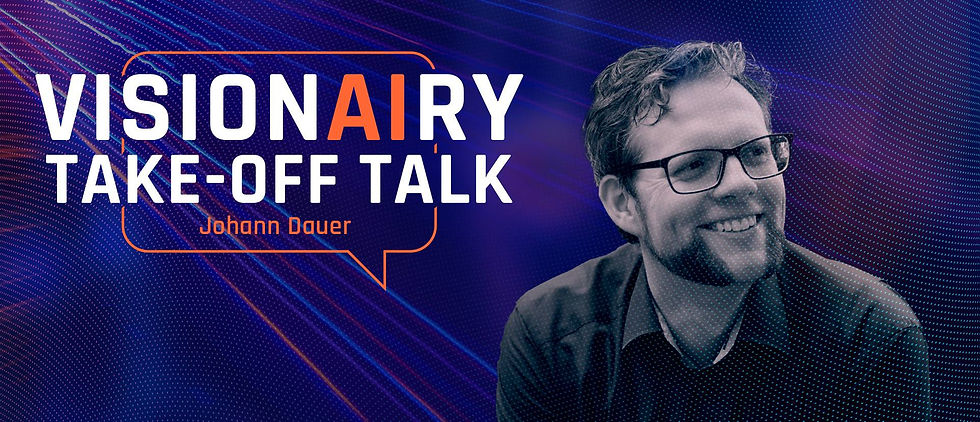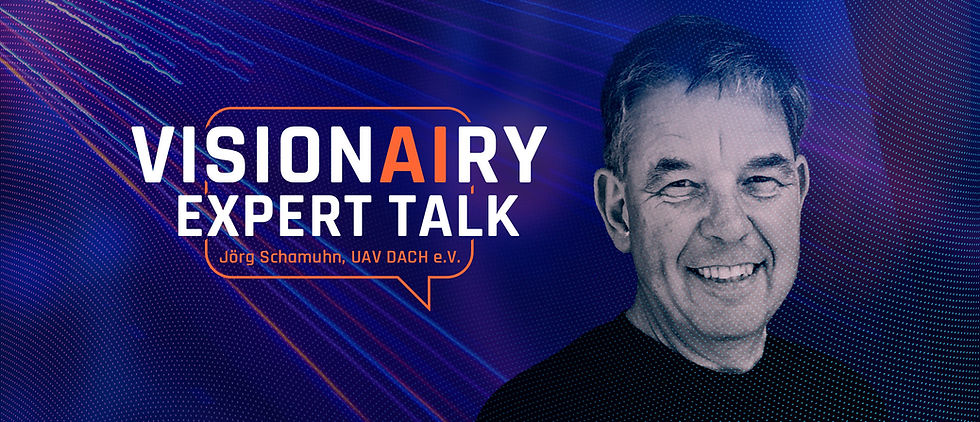VISIONAIRY TAKE-OFF TALK with Johann Dauer (DLR)
- janhartmann6
- Jun 22, 2022
- 3 min read

We spoke with Johann Dauer, Head of Department Unmanned Aircraft at the Institute of Flight Systems Engineering at the German Aerospace Center (DLR), about the use of AI and the challenges on the road to certification. Absolutely recommended reading!
1. DLR and Spleenlab are working together on the KI4Flight research project. How important is thisand subsequent projects for the fully automated BVLOS flight and the certification process?
In the KI4Flight project, we are working on the implementation of sensor systems including machine learning to enable robust and certifiable environmental perception. Such sensor suites enable a drone not only to map its environment, but also to provide it with semantic meaning. This capability is a basis of decision-making systems. It is therefore an essential capability for on-board autonomy and thus a key to beyond-visual-line-of-sight operations. However, to achieve this, we need complex and safety-critical software; the assurance of which is a challenging process. On top of that, KI4Flight uses artificial intelligence methods, the verification of which has still not been conclusively researched. Together, in KI4Flight, we are contributing on the way to safe autonomy and its certification.
2. How do start-ups contribute to the development of safe algorithms for unmanned aerial vehicles?
My team and I really enjoy working with start-ups. From our perspective, a start-up does not look back on a long history and is therefore not held back by past decisions and development legacy. That is why it seems easier to break new ground. Nowadays, the technological challenges are becoming increasingly complex. Thus, we need as many different approaches as possible to find the most promising. Start-ups can play an important role in this with the innovative paths they take.
3. What is the work of DLR and especially of your team like in general?
This question can only be answered with the words diverse and varying. Hardly any day unfolds identical to the next. As Department of Unmanned Aircraft, we are part of DLR´s research branch.
With our research, we are located somewhere between universities and industry. The research in my department is often more applied than at a methodologically oriented university. At the same time, we pick up on promising theories that are not yet sufficiently mature for implementation by companies and integrate them into a flying system. These aspects then culminate in the most rewarding aspect of the work for me – the flight tests and experiments.
In all of this, I find the diversity of DLR research particularly interesting. In recent years, for example, we have been able to think through unmanned cargo transport with larger payloads in their entirety – from business applications, aircraft configurations, airspace integration and autonomous technologies to the realization of prototypes and technology demonstrations. These diverse perspectives are only made possible by the many different topics of the institutes at DLR. We then publish the results of such research, as in this example, in the form of a book. Such complex and multi-layered research is only possible in very few institutions. In particular, the contributions of my team are dedicated to the developments of new demonstrators for unmanned aircraft, safery and assurance of autonomy and environmental perception.
4. In your opinion, what contribution does KI4Flight make to enabling flight taxis without pilots in Germany?
Quite clearly – KI4Flight contributes to the environmental perception of unmanned systems, be they drones and air taxis. If such systems are to take place in the future with little influence or without a pilot at all, the aircraft must automatically perceive and assess its environment. The flight paths must be monitored to be collision free, or the clearance of a landing platform needs to guaranteed. This is why environmental perception is mandatory for automatic flight. The road to fully autonomous passenger transport in Germany is still long – because the technologies have to be mature enough, the implementations certified and the infrastructure created. But it is precisely all these challenges that make the topics so exciting for our research at the moment.
5. What is the role of EASA recently published approaches to AI certification? Which areas require special attention in the coming years?
I find the approaches to certify AI, deep machine learning, that were published in recent years very impressive. The expansion of development processes for data-based system withinth CoDANN documents and the pillars of assurance of the “First usable guidance for Level 1 machine learning applications” are important milestones on the way to certify machine learning in aviation. Nevertheless, much remains to be investigated towards full autonomy and in-flight learning, i.e. adaptive systems.

